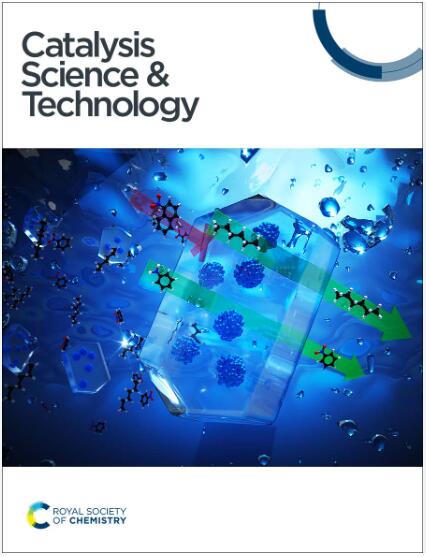催化过氧化氢用氟化仿生疏水气体扩散阴极的合成
IF 4.4
3区 化学
Q2 CHEMISTRY, PHYSICAL
引用次数: 0
摘要
酸性溶液中分散过氧化氢(H2O2)的电化学合成是电fenton (EF)工艺的重要研究方向。然而,为选择性双电子氧还原反应(2e-ORR)开发稳定、经济的催化剂仍然是一个挑战。本研究以天然玫瑰花瓣的疏水表面为灵感,模拟其微观结构,利用聚四氟乙烯(PTFE)的高附着力,将高导电性的乙炔炭黑(ACET)粘合在石墨毡网表面。这形成了一个低表面能、氟掺杂的疏水阴极,表面粗糙且缺陷丰富,有利于气体扩散。阴极的H2O2生成速率为46.21 mg h−1 cm−2,满足EF工艺的要求。在连续运行中,电极表现出优异的催化性能和稳定性。这可以归因于F/C掺杂和表面缺陷引起的电子分布密度的变化,其中高密度的电子畴在水合氢离子(h30 +)簇的界面上吸引氧分子,促进*OOH中间体的形成。界面的疏水性与*OOH结合较弱,有利于解吸,增强H2O2的生成,防止在湿电极表面发生析氢副反应,使生成的H2O2进一步还原为H2O。该研究为设计高效、稳定的阴极提供了新的策略,为未来催化剂的发现提供了指导。本文章由计算机程序翻译,如有差异,请以英文原文为准。
Synthesis of fluorinated biomimetic hydrophobic gas diffusion cathodes for catalytic hydrogen peroxide†
The electrochemical synthesis of dispersed hydrogen peroxide (H2O2) in acidic solutions is of significant interest for the electro-Fenton (EF) process. However, the development of robust and cost-effective catalysts for the selective two-electron oxygen reduction reaction (2e-ORR) remains a challenge. In this study, inspired by the hydrophobic surface of natural rose petals and mimicking their microstructure, we utilized the high adhesion property of polytetrafluoroethylene (PTFE) to bind highly conductive acetylene carbon black (ACET) onto the surface of graphite felt wire mesh. This formed a low-surface-energy, fluorine-doped hydrophobic cathode with a rough and defect-rich surface, optimized for gas diffusion. The cathode demonstrated an impressive H2O2 generation rate of 46.21 mg h−1 cm−2, meeting the requirements for the EF process. In continuous operation, the electrode exhibited exceptional catalytic performance and stability. This can be attributed to the variations in electron distribution density induced by F/C doping and surface defects, where high-density electron domains attract oxygen molecules at the interfaces of hydrated hydrogen ion (H3O+) clusters, promoting the formation of the *OOH intermediate. The hydrophobicity of the interfaces weakly bind to *OOH, favouring desorption to enhance H2O2 generation and prevent the side reaction of hydrogen evolution on the wetted electrode surface and further reduction of generated H2O2 to H2O. This study provides a new strategy for designing efficient and stable cathodes to guide future catalyst discovery.
求助全文
通过发布文献求助,成功后即可免费获取论文全文。
去求助
来源期刊

Catalysis Science & Technology
CHEMISTRY, PHYSICAL-
CiteScore
8.70
自引率
6.00%
发文量
587
审稿时长
1.5 months
期刊介绍:
A multidisciplinary journal focusing on cutting edge research across all fundamental science and technological aspects of catalysis.
Editor-in-chief: Bert Weckhuysen
Impact factor: 5.0
Time to first decision (peer reviewed only): 31 days
 求助内容:
求助内容: 应助结果提醒方式:
应助结果提醒方式:


